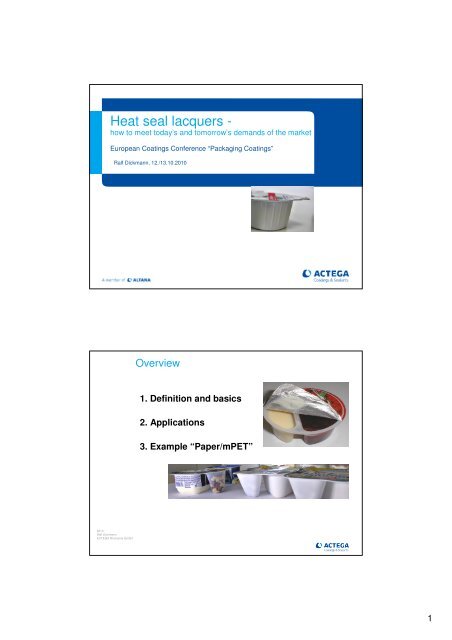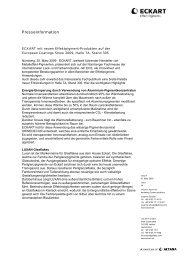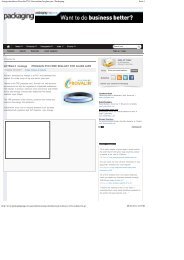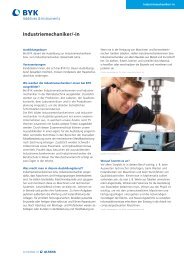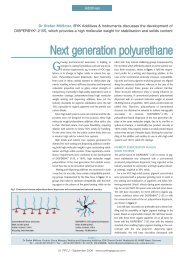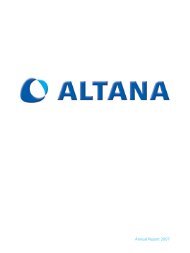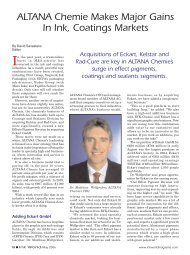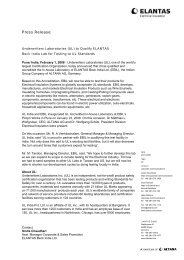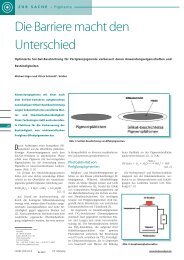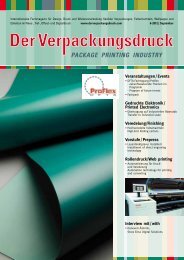Create successful ePaper yourself
Turn your PDF publications into a flip-book with our unique Google optimized e-Paper software.
<strong>Heat</strong> <strong>seal</strong> <strong>lacquers</strong> -<br />
how to meet today’s and tomorrow’s demands of the market<br />
European Coatings Conference “Packaging Coatings”<br />
Ralf Dickmann, 12./13.10.2010<br />
2010<br />
Ralf Dickmann<br />
ACTEGA Rhenania GmbH<br />
Overview<br />
1. Definition and basics<br />
2. Applications<br />
3. Example “Paper/mPET”<br />
1
2010<br />
Ralf Dickmann<br />
ACTEGA Rhenania GmbH<br />
2010<br />
Ralf Dickmann<br />
ACTEGA Rhenania GmbH<br />
What is a heat <strong>seal</strong> lacquer<br />
<strong>Heat</strong> <strong>seal</strong>:<br />
Two substrates are linked, tied, combined by the mean<br />
of heat and at least some pressure. One or both<br />
substrates have a heat <strong>seal</strong>able layer (or are heat<br />
<strong>seal</strong>able by themselves), which is activated by heat.<br />
Other methods to combine substrates:<br />
• Cold <strong>seal</strong> / pressure sensitive tape: no heat is necessary,<br />
mainly pressure<br />
• Adhesive lamination: both substrates are combined in-line<br />
What is a heat <strong>seal</strong> lacquer<br />
<strong>Heat</strong> <strong>seal</strong> lacquer:<br />
The heat <strong>seal</strong>able layer is produced by lacquering, the<br />
liquid, diluted phase is transformed to a dry coating by<br />
evaporating the solvents<br />
Other methods to produce heat <strong>seal</strong>able layer:<br />
• Coextrusion of a special heat <strong>seal</strong>able layer during film<br />
processing<br />
• Hot melt / extrusion coating: heat <strong>seal</strong>able layer is put on by<br />
heating up and subsequent coating on the substrate<br />
2
2010<br />
Ralf Dickmann<br />
ACTEGA Rhenania GmbH<br />
2010<br />
Ralf Dickmann<br />
ACTEGA Rhenania GmbH<br />
What is a heat <strong>seal</strong> lacquer<br />
Liquid coating, which is dried to become tack- and<br />
block- free, solidified, rewound and used later.<br />
<strong>Heat</strong> activated to become soft and tacky.<br />
Pressed to second substrate to make bond.<br />
Cooled to room temperature to form bond between<br />
layers of substrates.<br />
Typical heat <strong>seal</strong> process<br />
<strong>Heat</strong> <strong>seal</strong> coating<br />
During <strong>seal</strong><br />
process the heat<br />
<strong>seal</strong> coating (in<br />
melted state) has<br />
to give a tie / link<br />
with the cup<br />
Lid<br />
Pressure / <strong>Heat</strong><br />
Cup<br />
<strong>Heat</strong> <strong>seal</strong> coating<br />
has to adhere to<br />
lid- substrate<br />
3
2010<br />
Ralf Dickmann<br />
ACTEGA Rhenania GmbH<br />
2010<br />
Ralf Dickmann<br />
ACTEGA Rhenania GmbH<br />
Adhesion / Cohesion<br />
In order to give the expected performance, the<br />
heat <strong>seal</strong> lacquer has to adhere to both<br />
substrates and needs cohesive strength:<br />
Adhesion<br />
Cohesion<br />
Adhesion<br />
Criteria for <strong>Heat</strong> Seal Lacquers / areas of<br />
development<br />
Drying conditions,<br />
what solvents may<br />
be used<br />
Sealability at<br />
what conditions,<br />
Seal strength<br />
Opening<br />
behaviour<br />
(destructive or<br />
peel)<br />
<strong>seal</strong> partner<br />
Some<br />
Criteria<br />
hot tack<br />
What type of<br />
filling goods<br />
(product<br />
resistance)<br />
optical<br />
appearance<br />
(of lacquer<br />
and <strong>seal</strong>)<br />
blocking<br />
resistance<br />
4
2010<br />
Ralf Dickmann<br />
ACTEGA Rhenania GmbH<br />
2010<br />
Ralf Dickmann<br />
ACTEGA Rhenania GmbH<br />
Criteria for <strong>Heat</strong> Seal Lacquers / areas of<br />
development Example<br />
Opening<br />
behaviour<br />
(destructive or<br />
peel)<br />
Seal Partners<br />
Dairy packing should open<br />
“smoothly”, but still remain<br />
integer during transport!<br />
Lid should not tear, there<br />
should be no rupture<br />
PVC: Polyvinyl chloride<br />
PS: Polystyrene<br />
PP: Polypropylene<br />
PE: Polyethylene<br />
A-PET: Amorphous Polyethylene<br />
terephthalate<br />
Typical uses:<br />
PS and PP (“softer” than PS) and PE in combination with<br />
cardboard for diary packaging;<br />
PVC for pharmaceutical blister;<br />
A-PET for diary packaging (transparent, barrier properties)<br />
5
2010<br />
Ralf Dickmann<br />
ACTEGA Rhenania GmbH<br />
2010<br />
Ralf Dickmann<br />
ACTEGA Rhenania GmbH<br />
Basics of heat <strong>seal</strong> lacquer formulations<br />
(non- coloured)<br />
Solvents:<br />
�Low boiling: for example: ethyl acetate<br />
�Medium boiling: for example: butyl acetate<br />
�High boiling: for example: aromatic solvents<br />
Resins:<br />
•Thermoplastic resins to give <strong>seal</strong>ability (see next slide)<br />
•Resins to give adhesion to substrate<br />
•Other resins for special performance<br />
Basics of heat <strong>seal</strong> lacquer formulations<br />
Thermoplastic resins to give <strong>seal</strong>ability<br />
•Vinylic (PVC and PVDC based)<br />
•Acrylate and styrene acrylate based<br />
•Acrylate / Polyolefin<br />
•Styrene (copolymer) based<br />
•Polyester based<br />
•PP- Dispersion<br />
•EVA/EAA/EMAA<br />
6
2010<br />
Ralf Dickmann<br />
ACTEGA Rhenania GmbH<br />
2010<br />
Ralf Dickmann<br />
ACTEGA Rhenania GmbH<br />
Basics of heat <strong>seal</strong> lacquer formulations<br />
Additives:<br />
�Waxes / Slip agents (for slip properties, release, antiblock,<br />
<strong>seal</strong> performance): Polyethylene wax, Carnauba wax, PTFE,<br />
Fatty acid ester<br />
�Inorganic pigments / filler (for antiblock, for haptic/optical<br />
properties, for <strong>seal</strong> performance, for viscosity control): Silica,<br />
talc<br />
�Antioxidants / UV- stabilizer / optical brighteners<br />
�Antifoam (in water based products)<br />
�Adhesion promoter: Epoxy resins for Aluminium substrates<br />
Basics of heat <strong>seal</strong> lacquer formulations<br />
Appearance / Stirring:<br />
�Typically no stable solution<br />
�<strong>Heat</strong> <strong>seal</strong> <strong>lacquers</strong> have to be<br />
stirred well before application<br />
<strong>Heat</strong> <strong>seal</strong> lacquer with filler<br />
before (left) and after stirring (right)<br />
Segregation / “dephasing”<br />
of a heat <strong>seal</strong> lacquer<br />
without filler<br />
7
2010<br />
Ralf Dickmann<br />
ACTEGA Rhenania GmbH<br />
2010<br />
Ralf Dickmann<br />
ACTEGA Rhenania GmbH<br />
New developments:<br />
Market pull / Technology push<br />
Market pull:<br />
�New requirements for existing packages (for<br />
example new food law regulations)<br />
�New packages<br />
Technology push:<br />
�New products based on existing technologies /<br />
formulations<br />
�New technologies<br />
Some Applications<br />
•Blister Foils for Pharmaceutical Products<br />
•Lids for sterilizable Containers<br />
•Composite Cans<br />
•Lids for Food packages (especially dairy)<br />
* for Aluminium Foils<br />
* for PET- Films and Paper/PET<br />
8
2010<br />
Ralf Dickmann<br />
ACTEGA Rhenania GmbH<br />
2010<br />
Ralf Dickmann<br />
ACTEGA Rhenania GmbH<br />
Blister Foils for Pharmaceutical Products<br />
<strong>Heat</strong> <strong>seal</strong> coating based<br />
on PVC or PVC/Acrylate (<strong>seal</strong>able to PVC<br />
or PVDC- Blister)<br />
Universal <strong>Heat</strong> <strong>seal</strong> coating (<strong>seal</strong>able to<br />
PP-Blister)<br />
Aluminium foil with<br />
heat <strong>seal</strong> coating<br />
Blister<br />
Lids for sterilizable Containers<br />
<strong>Heat</strong> <strong>seal</strong> coating on epoxy<br />
resin basis <strong>seal</strong>able to PP<br />
<strong>Heat</strong> <strong>seal</strong> coating PVC-based<br />
Lid: Aluminium foil with heat<br />
<strong>seal</strong> coating<br />
Tray: Alu-PP laminate<br />
(deep drawn)<br />
9
2010<br />
Ralf Dickmann<br />
ACTEGA Rhenania GmbH<br />
2010<br />
Ralf Dickmann<br />
ACTEGA Rhenania GmbH<br />
Composite Cans<br />
Paper- / Composite Cans<br />
Internal Protective- / <strong>Heat</strong><br />
<strong>seal</strong> coatings PVC and<br />
Polyester based<br />
Paper / Aluminium foil laminate<br />
with heat <strong>seal</strong> coating<br />
In this case folded, <strong>seal</strong>ed lacquer<br />
to lacquer<br />
Lids for Food packages<br />
<strong>Heat</strong> <strong>seal</strong> coating based<br />
on PVC or PVC/Acrylate,<br />
<strong>seal</strong>able to PVC / PS / APET<br />
Universal <strong>Heat</strong> <strong>seal</strong> coating<br />
<strong>seal</strong>able to APET / PP / PVC / PS<br />
<strong>Heat</strong> <strong>seal</strong> coating based<br />
on polyester, <strong>seal</strong>able to APET /<br />
PVC, or itself<br />
Aluminium foil with<br />
heat <strong>seal</strong> coating<br />
PP Cup<br />
10
2010<br />
Ralf Dickmann<br />
ACTEGA Rhenania GmbH<br />
2010<br />
Ralf Dickmann<br />
ACTEGA Rhenania GmbH<br />
Lids for Food packages<br />
<strong>Heat</strong> <strong>seal</strong> coating on PET (1- or 2- layer),<br />
<strong>seal</strong>able to APET, PS, PP or Aluminium<br />
<strong>Heat</strong> <strong>seal</strong> coating for salad packaging<br />
White PET film with<br />
heat <strong>seal</strong> coating<br />
PP tray<br />
Lids for Food packages<br />
<strong>Heat</strong> <strong>seal</strong> coating for Chocolate Cream,<br />
chocolates packaging<br />
<strong>Heat</strong> <strong>seal</strong> coating<br />
applied on entire<br />
surface or “in<br />
pattern”<br />
Printed mPET film<br />
with heat <strong>seal</strong><br />
coating<br />
APET tray<br />
Printed PET film with<br />
heat <strong>seal</strong> coating<br />
APET tray<br />
11
2010<br />
Ralf Dickmann<br />
ACTEGA Rhenania GmbH<br />
2010<br />
Ralf Dickmann<br />
ACTEGA Rhenania GmbH<br />
Paper/PET- Lid material for PS- Cups<br />
Lid material paper/Polyester<br />
or paper/metallised PET as<br />
replacement for aluminium<br />
lids.<br />
Delaminated: Printed Paper<br />
and mPET with <strong>Heat</strong> <strong>seal</strong><br />
coating<br />
Example “Paper/mPET”<br />
Classification:<br />
2- layer (Primer and <strong>Heat</strong> <strong>seal</strong> coating) or<br />
1- layer<br />
Low / medium / high <strong>seal</strong><br />
PVC (chlorine) containing or free<br />
Printed Paper / mPET<br />
with <strong>Heat</strong> <strong>seal</strong> coating<br />
PS Cup<br />
12
2010<br />
Ralf Dickmann<br />
ACTEGA Rhenania GmbH<br />
2010<br />
Ralf Dickmann<br />
ACTEGA Rhenania GmbH<br />
2- layer- system<br />
Classic Construction:<br />
1- layer- system<br />
Overprint varnish<br />
Printing ink<br />
Primer<br />
Paper<br />
Adhesive<br />
Metallised<br />
Polyester<br />
Primer<br />
<strong>Heat</strong> <strong>seal</strong> coating<br />
<strong>Heat</strong> <strong>seal</strong> without Primer = 1 layer<br />
Adhesion on non-treated PET- side of the<br />
Paper/mPET- laminate, <strong>seal</strong>s to PS Cups<br />
Overprint varnish<br />
Printing ink<br />
Primer<br />
Paper<br />
Adhesive<br />
Metallised<br />
Polyester<br />
Primer<br />
<strong>Heat</strong> <strong>seal</strong> coating<br />
13
2010<br />
Ralf Dickmann<br />
ACTEGA Rhenania GmbH<br />
2010<br />
Ralf Dickmann<br />
ACTEGA Rhenania GmbH<br />
Some details<br />
In a typical “Paper/mPET” single layer heat <strong>seal</strong> lacquer<br />
minimum two main components are included:<br />
One component to give anchorage to the PET surface,<br />
typically also a polyester resin. (NC or PVC resin for<br />
example do not adhere.)<br />
Second component which <strong>seal</strong>s to PS (typically a resin<br />
based on acrylate and/or styrene copolymer).<br />
<strong>Heat</strong> <strong>seal</strong> coating<br />
has to <strong>seal</strong> to PS<br />
<strong>Heat</strong> <strong>seal</strong> coating has to<br />
adhere to PET<br />
Paper/PET- Lid material for PS- Cups<br />
2- layer<br />
PVC free PVC containing<br />
Low <strong>seal</strong><br />
Medium <strong>seal</strong><br />
High <strong>seal</strong><br />
1- layer<br />
Low <strong>seal</strong><br />
Medium <strong>seal</strong><br />
High <strong>seal</strong><br />
14
2010<br />
Ralf Dickmann<br />
ACTEGA Rhenania GmbH<br />
2010<br />
Ralf Dickmann<br />
ACTEGA Rhenania GmbH<br />
Quality characteristics<br />
• Seal strength<br />
• „Hot tack“ (<strong>seal</strong> strength immediately after <strong>seal</strong>ing, in warm<br />
condition)<br />
• Compliance with health standards<br />
• Machinability<br />
• Coating weight<br />
• Price per kg and – most important - price per m² coated area<br />
Some laboratory tests<br />
Cup <strong>seal</strong>ing and evaluation of the<br />
<strong>seal</strong> performance:<br />
15
2010<br />
Ralf Dickmann<br />
ACTEGA Rhenania GmbH<br />
2010<br />
Ralf Dickmann<br />
ACTEGA Rhenania GmbH<br />
Some laboratory tests<br />
Control of <strong>seal</strong> strength including „hot-tack“<br />
measurement device:<br />
PET with <strong>Heat</strong> <strong>seal</strong><br />
coating<br />
PS Stripe<br />
Closing remarks<br />
- Every day objects<br />
Force/distance<br />
diagram<br />
- There is a lot of knowledge behind it<br />
- Ongoing changes<br />
- New developments by market pull and<br />
technology push<br />
16
Thank you for<br />
your attention.<br />
17


